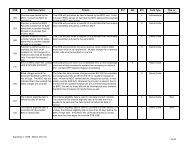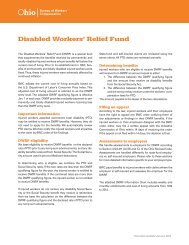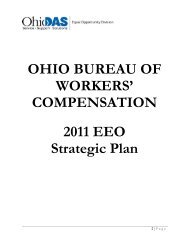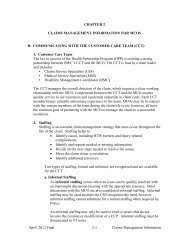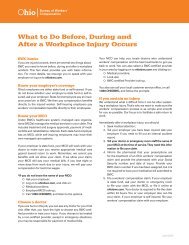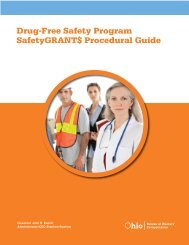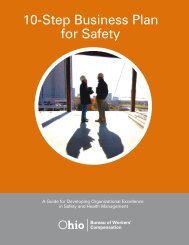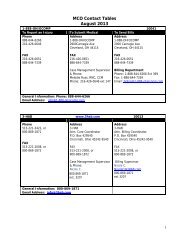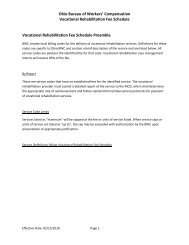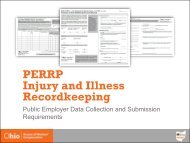Best Practices for Schools - Ohio Bureau of Workers' Compensation
Best Practices for Schools - Ohio Bureau of Workers' Compensation
Best Practices for Schools - Ohio Bureau of Workers' Compensation
Create successful ePaper yourself
Turn your PDF publications into a flip-book with our unique Google optimized e-Paper software.
<strong>Best</strong> <strong>Practices</strong> <strong>for</strong> <strong>Schools</strong><br />
• Hold monthly/quarterly employee <strong>for</strong>ums with the superintendent;<br />
• Conduct one-on-one interaction on a daily basis. Attempt to address safety issues and<br />
concerns using the quickest methods and at the lowest level possible rather than waiting<br />
<strong>for</strong> the next committee meeting or <strong>for</strong>um. Communicate safety issues addressed at<br />
the local level. Communicate to the committee or the <strong>for</strong>ums so the entire organization<br />
can benefit from knowing what the safety issue was and how it was addressed;<br />
• One school district conducted a mini safety perception survey. A comprehensive perception<br />
survey is available through the Division <strong>of</strong> Safety & Hygiene. Contact your local<br />
customer service <strong>of</strong>fice <strong>for</strong> details.<br />
“Safety is a day-to-day thing. I try to take advantage <strong>of</strong> daily interactions with my employees,<br />
constantly stressing to them the importance <strong>of</strong> practicing safe work habits during<br />
their daily operations,” — Al Yano, service manager, Independence City <strong>Schools</strong><br />
Safety education and training<br />
All school districts interviewed by us stress the importance <strong>of</strong> safety education and training.<br />
Safety education and training begins with the top administration. Often, however, top<br />
administration does not fully understand workplace safety issues or the workers’ compensation<br />
system. As one school administrator put it, “You first have to educate the educators.”<br />
BWC employer services specialists are available to meet with you to discuss your workers’<br />
compensation history, analyze your practices and recommend improvements. And Division<br />
<strong>of</strong> Safety & Hygiene safety consultants are available to meet with you to analyze safety<br />
culture and practices, and recommend improvements. In addition, there is a multitude <strong>of</strong><br />
Division <strong>of</strong> Safety & Hygiene training courses available to help you better understand workers’<br />
compensation and safety-management strategies.<br />
Safety education and training <strong>for</strong> employees — principals, assistant principals, supervisors,<br />
teachers, counselors, custodians, food service employees, groundskeepers, etc. — are<br />
just as important. Here are things you can do to make your employee safety education and<br />
training effective:<br />
• Implement an effective new employee orientation process;<br />
• Conduct employee in-service training;<br />
• Provide job-specific training to all employees;<br />
• Take advantage <strong>of</strong> all training opportunities through your local education associations,<br />
third-party administrators (TPAs) or other sources;<br />
• Use the training seminars and videotapes available through the Division <strong>of</strong> Safety & Hygiene.<br />
Most schools conduct the bulk <strong>of</strong> their in-service training at the start <strong>of</strong> the school year.<br />
However, one district surveyed by us conducts training <strong>for</strong> classified employees in the<br />
summer months. Another district views training as so important that it appointed a training<br />
coordinator to oversee all training.<br />
Employees may perceive in-service training provided by an outside source as more credible<br />
and, there<strong>for</strong>e, have a greater impact.<br />
Injury reporting and treatment<br />
First, <strong>for</strong>malize the injury reporting and treatment process. Document it in writing. Then<br />
ensure it is well communicated and understood by all employees <strong>of</strong> the school district. And<br />
make sure injured employees report all injuries, no matter how minor, to their supervisor.




